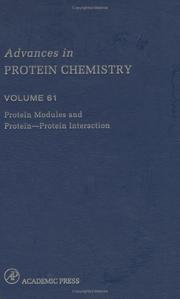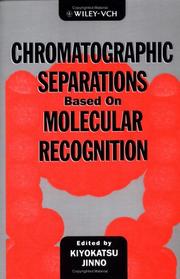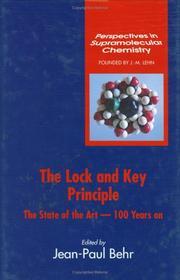| Listing 1 - 10 of 50 | << page >> |
Sort by
|

ISBN: 0120342618 9786611010676 1281010677 0080493750 9780120342617 9781281010674 9780120342617 661101067X 9780080493756 Year: 2003 Publisher: New York, NY ; London : Academic Press,
Abstract | Keywords | Export | Availability | Bookmark
 Loading...
Loading...Choose an application
- Reference Manager
- EndNote
- RefWorks (Direct export to RefWorks)
Protein modules engage in a multitude of interactions with one another and with other cellular components, notably with DNA. These interactions are a central aspect of protein function of great relevance in the post-genomic era. This volume describes a panel of approaches for analyzing protein modules and their interactions, ranging from bioinformatics to physical chemistry, to biochemistry, with an emphasis on the structure-function relationship in protein-protein complexes involved in cellular processes including signal transduction.Key Features* Comprehensive overview of differe

ISBN: 0471188948 Year: 1997 Publisher: New York (N.Y.) : Wiley-VCH,
Abstract | Keywords | Export | Availability | Bookmark
 Loading...
Loading...Choose an application
- Reference Manager
- EndNote
- RefWorks (Direct export to RefWorks)
Book
Year: 1984 Publisher: Boca Raton: CRC,
Abstract | Keywords | Export | Availability | Bookmark
 Loading...
Loading...Choose an application
- Reference Manager
- EndNote
- RefWorks (Direct export to RefWorks)
Book
ISBN: 1612094783 9781612094786 9781611227345 1611227348 Year: 2011 Publisher: New York : Nova Science Publishers,
Abstract | Keywords | Export | Availability | Bookmark
 Loading...
Loading...Choose an application
- Reference Manager
- EndNote
- RefWorks (Direct export to RefWorks)
Article
Abstract | Keywords | Export | Availability | Bookmark
 Loading...
Loading...Choose an application
- Reference Manager
- EndNote
- RefWorks (Direct export to RefWorks)
Article
Year: 2000
Abstract | Keywords | Export | Availability | Bookmark
 Loading...
Loading...Choose an application
- Reference Manager
- EndNote
- RefWorks (Direct export to RefWorks)
Article
Year: 2000
Abstract | Keywords | Export | Availability | Bookmark
 Loading...
Loading...Choose an application
- Reference Manager
- EndNote
- RefWorks (Direct export to RefWorks)

ISBN: 0471939021 Year: 1994 Volume: v. 1 Publisher: Chichester : Wiley,
Abstract | Keywords | Export | Availability | Bookmark
 Loading...
Loading...Choose an application
- Reference Manager
- EndNote
- RefWorks (Direct export to RefWorks)
Perspectives in Supramolecular Chemistry will relate recent developments and new exciting approaches in supramolecular chemistry. In supramolecular chemistry, our aim is to understand the molecular chemistry beyond the covalent bond& the series will concentrate on goal-orientated supramolecular chemistry. Perspectives in Supramolecular Chemistry will reflect research which develops supramolecular structures with specific new properties, such as recognition, transport and simulation of biosystems or new materials. The series will cover all areas from theoretical and modelling aspects through organic and inorganic chemistry and biochemistry to materials, solid-state and polymer sciences, reflecting the many and varied applications of supramolecular structures in modern chemistry. The Lock and Key Principle The State of the Art& 100 Years on Edited by Jean-Paul Behr Published 100 years after Emil Fischer first proposed the lock-and-key principle, this volume provides a complete review of the subject to date and offers suggestions for further research. The major impact of the lock-and-key principle on the chemical, biomedical and materials sciences is discussed by leaders in the field, with chapters dedicated to molecular recognition, nucleic acid and protein chemistry, crystallography and the development of Emil Fischer's initial ideas. The Lock-and-Key Principle is the most up-to-date review of progress in supramolecular chemistry and the lock-and-key principle, and will become the essential guide to the past, present and future of this remarkable idea. The interdisciplinary nature of this topic is highlighted in The Lock-and-Key Principle ensuring that this volume is essential reading for chemists, molecular biologists, biochemists and materials scientists working in the areas of molecular recognition, enzymology, immunology, protein and nucleic acid chemistry, crystallography, bioinorganic and bioorganic chemistry and supramolecular chemistry.
Molecular recognition. --- Reconnaissance moléculaire --- Reconnaissance moléculaire
Book
ISBN: 9780883189030 0883189038 Year: 1989 Publisher: Washington (Wash.): American crystallographic association,
Abstract | Keywords | Export | Availability | Bookmark
 Loading...
Loading...Choose an application
- Reference Manager
- EndNote
- RefWorks (Direct export to RefWorks)
Protein binding --- Carbohydrates --- Molecular recognition --- Proteins
Book
ISSN: 00976156 ISBN: 0841216851 9780841216853 Year: 1998 Volume: 703 Publisher: Washington, District of Columbia : American Chemical Society,
Abstract | Keywords | Export | Availability | Bookmark
 Loading...
Loading...Choose an application
- Reference Manager
- EndNote
- RefWorks (Direct export to RefWorks)
Imprinted polymers --- Molecular imprinting --- Molecular recognition
| Listing 1 - 10 of 50 | << page >> |
Sort by
|

 Search
Search Feedback
Feedback About UniCat
About UniCat  Help
Help News
News